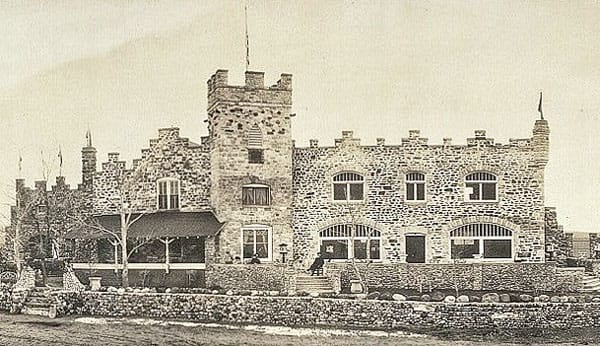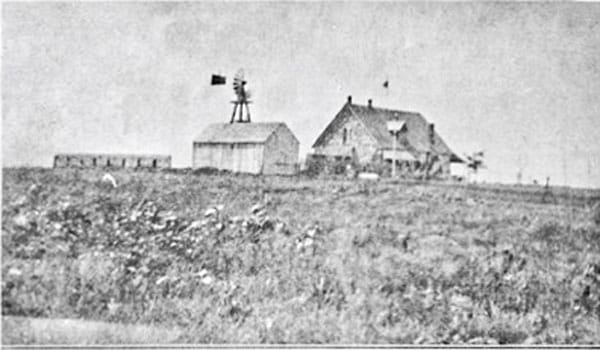Wildcat Mountain castles

Springer Ranch in metamorphosis, 1905-1910. Look at leftmost windows under crenellated eave. John Springer incorporated Rotherwood homestead into the expanded Springer-Cross Country Ranch.
By Joe Gschwendtner; photos courtesy of Josephine Marr’s “A Historical Journey” and the Douglas County History Research Center
Riveting history often includes stories of places larger than life. In the northern Wildcat Mountains, there were two castles of note: the Springer Cross Country Mansion and the Cherokee Castle. Somewhat on the smaller side, neither compared favorably to great architectural treasures of Europe. Regarding the personalities and accomplishments of their owners, you may be the judge …
The Springer Mansion began as a modest home on the northern Wildcat bluffs in 1884 by Pennsylvanian Samuel Long. Long named it Rotherwood after a much-loved boyhood farm. Seven years later, an ambitious German, John Springer, was drawn to the same area to mitigate his wife’s debilitating health condition.
Springer was a shrewd businessman with demonstrable successes in the banking, commerce and packing industries. His property purchases in 1891 and in 1897 included the Long Ranch. Now almost 12,000 acres, Springer renamed it the Springer Cross Country Ranch and used Oldenburg stallions and mares as breeding stock. Objective: to raise the ideal American coach horse.

Courtesy of Josephine Marr’s “A Historical Journey.” This picture is believed to be Samuel Long’s stone homestead.
Fortune did not carry over to Springer’s personal life. Ailing wife Eliza, daughter of wealthy Colonel William Hughes, died in 1904. By 1909, Springer was smitten with a St. Louis divorcee, one Isabelle Patterson, and he married her. Unfaithful early on, Isabelle’s behavior was outed in lurid detail when an alleged lover, a balloonist, was murdered in the Brown Palace in 1911. This scandal was too much for Springer, and he divorced Isabelle after the murder, selling the ranch back to Colonel Hughes.
Renamed Sunland Ranch, it would be expanded and remodeled by many future owners. By 1920, Colonel Hughes’ daughter Annie and her husband moved on, selling the ranch to Waite Phillips of Phillips Petroleum in Oklahoma. Six years later, also tiring of his toy ranch, Phillips sold to another oilman and Denver socialite, Frank Kistler. Renaming it the Diamond K Ranch, he and wife Florence ramped things up and became the talk of the town, generating rivers of ink in the society column. Frank’s interests were in stock breeding, and he broadened and redirected the scope of farm’s operations to that end.
As can often happen when money lubricates a relationship, Frank and Florence’s began to disintegrate. When the dust cleared, it left a family in massive disarray and mixed loyalties among the six children involved. But the entertaining continued on unabated and a major home expansion from Gothic to more Tudor-styling was finished in 1931. Unfortunately, Frank’s investments were devastated during the Great Depression leaving him in an impossibly, vulnerable financial position by 1936.
Kistler’s liquidation of the Ranch came via the Arapahoe Hunt Club, which had earlier relocated from its Denver Country Club headquarters to the Diamond K. Lawrence Phipps Jr., long a fancier of horse and hound hunting, was a club member and also an investor in ranchland in the area, having just closed on the Welte Cheese Ranch. In 1937, Phipps allegedly offered Kistler $250,000. When the offer was accepted and properties consolidated, the 22,000-acre parcel became known as Highlands Ranch.
More to come next month …